After a back injury a lot of people think that resting is the best thing to do, but that is actually the worst thing you can do. Exercises for lower back pain strengthen your core muscles, including your lower back, so it is very important to get your back moving and not let it seize up.
There are many exercises to help lower back pain, which I am going to show you today, but there are also some exercises that can cause more harm than good.
In this article, we will discuss the best exercises to try and ease that lower back pain that has been giving you so much trouble. But, before we discuss the best exercises let’s take a look at some exercises that we should avoid and have a look at some better alternative exercises.
Exercises to Avoid and Alternatives
AVOID: Standing Toe Touches
It is common to have tight hamstrings after a workout, which can contribute to back pain, and it is important to stretch to stretch to prevent further injury.
Standing toe touches might seem like the best ecercise to stretch your hamstrings and back out after a workout.
However, standing toe touches compress the spine beyond what it is meant to do, which can cause more serious injuries if you already have lower problems.
ALTERNATIVE EXERCISE: Hamstring Stretches with Towel
Performing hamstring stretches with a towel is a lot better and safer exercise to strectch as it puts a lot less pressure on your lower back.
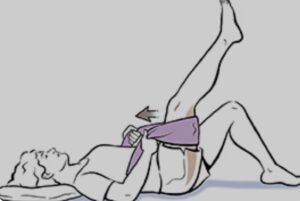
How to perform exercise…
- Lie on your back with your knees bent and feet flat on the floor.
- Make sure you are relaxed and feel comfortable.
- Put a towel behind your thigh.
- Use the towel to pull your leg towards your chest, keeping the leg straight or slightly bent.
- Hold for 40 to 60 seconds. Then lower the leg.
- Switch Legs.
- Repeat 2 to 3 times.
AVOID: Superman Back Extensions
To perform superman back extensions you…
- Lie with your chest flat on the floor, with your arms straight out in front of you.
- Raise your arms by squeeze your glutes and lower back, whilst lifting your chest off the floor.
- Hold for a 2-3 seconds, then slowly return to the starting position, whilst keeping your arms and legs off the floor.
This generates a large amount of stress to the joints and muscles in the low back, which can cause a lot of discomfort and potentially further injury.
ALTERNATIVE EXERCISE: The Bird Dog
The bird dog is a simple core exercise that improves stability, and relieves low back pain. It uses the whole body to target and strengthen your core, hips, and back muscles. It also helps promote proper posture and increase range of motion.
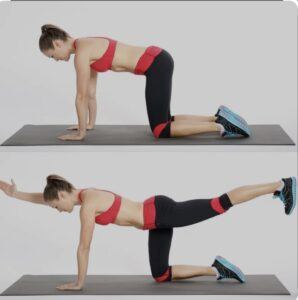
How to perform exercise…
- Get on all fours with wrists under shoulders and knees under hips.
- Engage pelvic floor muscles.
- Raise your left arm in front of you and right leg behind, engaging your glutes.
- Hold for a second, then return to start. Repeat with opposite arm and leg.
Causes of Lower Back Pain
There are two different types of lower back pain, specific and non specific.
Specific Lower Back Pain
Specific lower back pain, when there is a specific cause for your pain.
This could be due to any of the following…
- A slipped disk.
- A fractured vertabrae.
- Facet joint pain.
Non-Specific Back Pain
Non-specific lower back pain, is when there is no specific cause for you back pain.
This could be due to any of the following…
- Not moving around much.
- Being overweight.
- Lifting something heavy.
- Having a physical job that places stress on your lower back.
- Standing in same spot for too long.
Top 5 Stretches to Help Lower Back
1. Trunk Rotatoion
The trunk rotation can help ease tension in your lower back. It also works your core muscles, your abdominals, back muscles, and the muscles around your pelvis.

How to perform exercise…
- Sit down on the floor or a mat. Keep your feet together, bend your knees, and place your feet flat on the floor.
- Hold a medicine ball close to your body. Sit with your spine straight and your torso square to the floor, keeping your core muscles tight.
- Exhale and slowly rotate your torso to the left, making sure you do not lean back towards the floor, and keep the ball close to your chest as you rotate.
- Pause at the end of the rotation, inhale and rotate back to the starting position.
- Perform the same movement again but rotating to the right.
- Rrpeat rotation 3 times for each side.
2. Knee to Chest Stretch
The knee-to-chest stretch is one of the best exercises you can do to relieve muscle tension in your low back and hips. It can also improve the flexibility in your hips, hamstrings, and glutes.
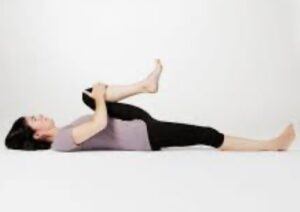
How to perform exercise…
- Lie on your back with your knees bent and place your feet flat on the floor.
- Grab hold of your right lower leg with both hands, just under your knee.
- Gently pull your right knee to your chest until you feel a slight stretch in your lower back.
- Hold your right knee against your chest for 45–60 seconds, whilst keeping your legs, hips and back relaxed.
- Return your right knee back to the starting position.
- Repeat stretch on left leg.
- Repeat stretch 3 times for each leg.
3. The Pelvic Tilt
The pelvic tilt is a very easy but effective exercise to relieve muscle tension in your lower back.
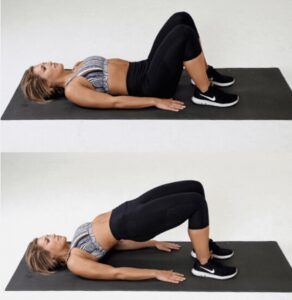
How to perform exercise…
- Lie on your back with your knees bent and pace your feet flat on the floor.
- Place hands near the base of your head (as if you’re about to perform a situp).
- Push your pelvis up slightly toward the ceiling while tightening your abdominal and buttock muscles.
- Hold for 5–10 seconds, then relax.
- Start by performing anywhere up to 15 reps, building up to around 30 reps a day.
4. Cat Cow
Aswel as the pelvic tilt, cat cow is also a very easy but effective exercise to relieve tension in your lower back and increase flexibility.
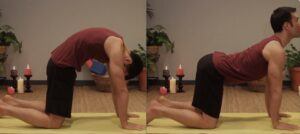
How to perform exercise…
- Get onto all fours with your knees hip-width apart.
- Pull your belly up towards your spine, arching your back, with your head dropping forward.
- Hold for 5–10 seconds, until you feel a slight stretch in your lower back.
- Return to the starting position.
- Raise your head, whilst letting your pelvis fall forward, curving your back down toward the floor.
- Hold for 5–10 seconds, then return to the starting position.
- Perfom around 10-15 reps.
5. Childs Pose
Child’s pose is a forward bending stretch that helps relieve stiffness and tension in the lower back. It is also a very good exercise to promote better flexibility in several parts of your body.
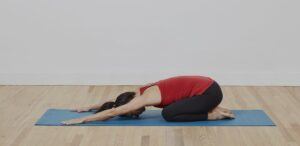
How to perform exercise…
- Start with your knees apart, facing outwards, and toes touching.
- Reach out in front of you and push your bum back towards your heels.
- Hold pose for around 30 seconds.
- Repeat 5 times.
When Should You Seek Medical Help For Lower Back Pain?
Almost everybody will experience some kind of back back in their life, whether it is upper, middle, or lower back pain. Lower back pain is the most common, but the pain goes away over time.
If you lower pain is severe you should seek medical help immediately.
For lower back pain that is not severe, try taking an over-the-counter pain reliever like aspirin or ibuprofen, and apply ice on your back in the first 48 hours, to try and relieve the pain.
If your back pain stops you from working or doing your general daily activities for more than 2 weeks, then you should seek medical help.
It is also important that you do not perform any of the exercises or stretches listed above without seeking medical help first, as if it is a more severe injury than you thought, these exercise could make it worse.
Final Say: The Road to Recovery
Although these exercises should help decrease lower back pain, it is important to know why the pain is occurring in the first place.
You should seek medical help before trying any of these exercises if you have any worries that the pain could be severe.
A physiotherapist can help determine the root cause of the problem if these exercises don’t help you, and set out a personal program to suit your needs.
I hope this article helps you to overcome your lower back pain and gives you a better understanding of what exercises to perform and not to perform to help it repair fully.
If you have any questions about lower back pain or about fitness in general, leave a comment below and I will get back to you as soon as possible.
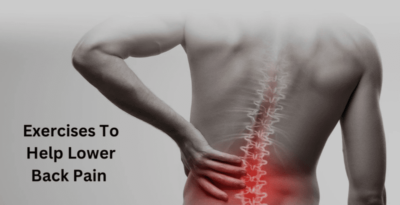
The article gives some very good tips on recovery exercises and is helpful as regards to over exercising.
Having had back pain for some years I can clarify that the exercises listed do help to ease the pain.
Thank you. I’m glad the article helped you. If you have any questions about back pain or anything else fitness related feel free to message and I will reply as soon as possible.